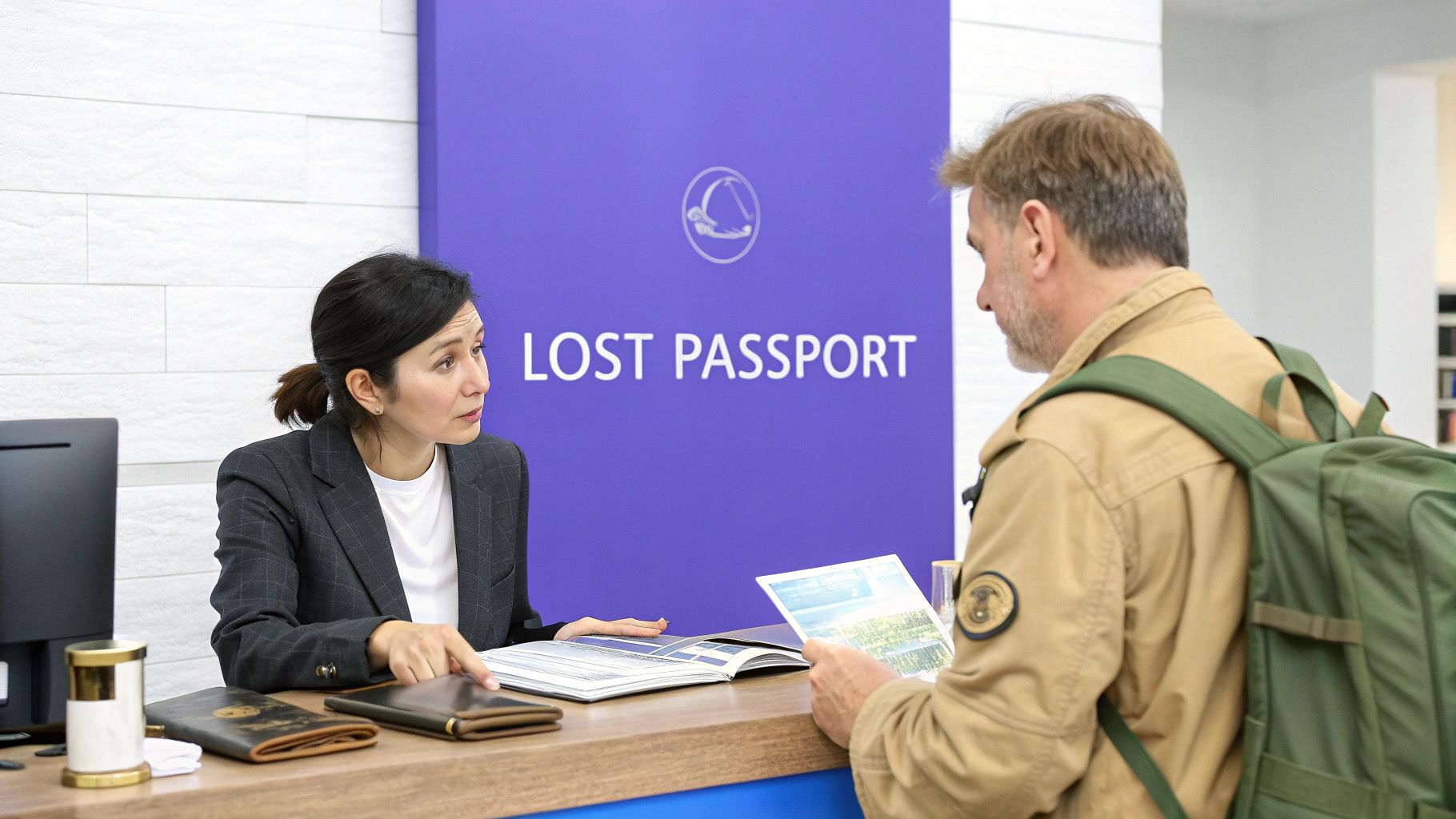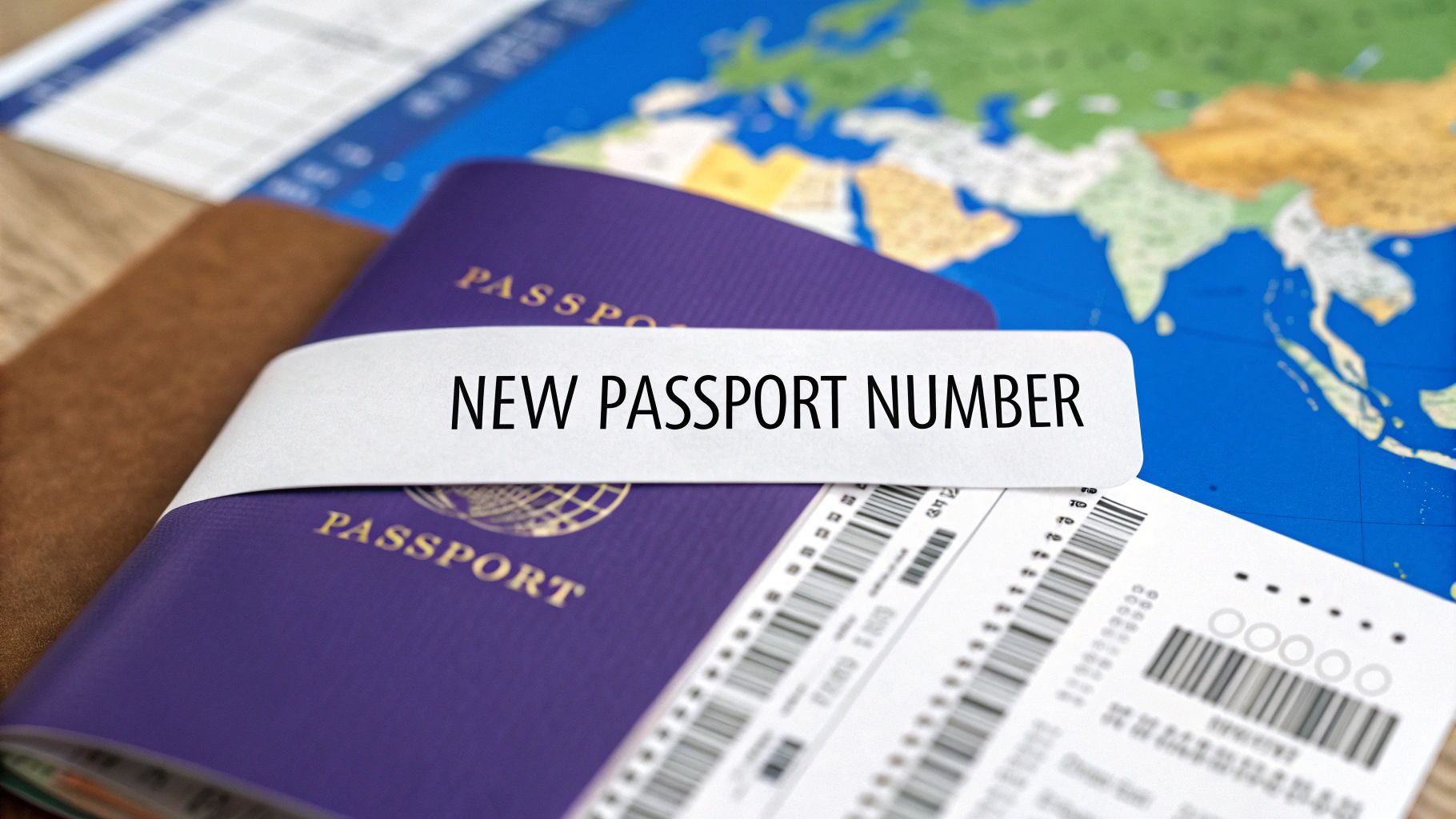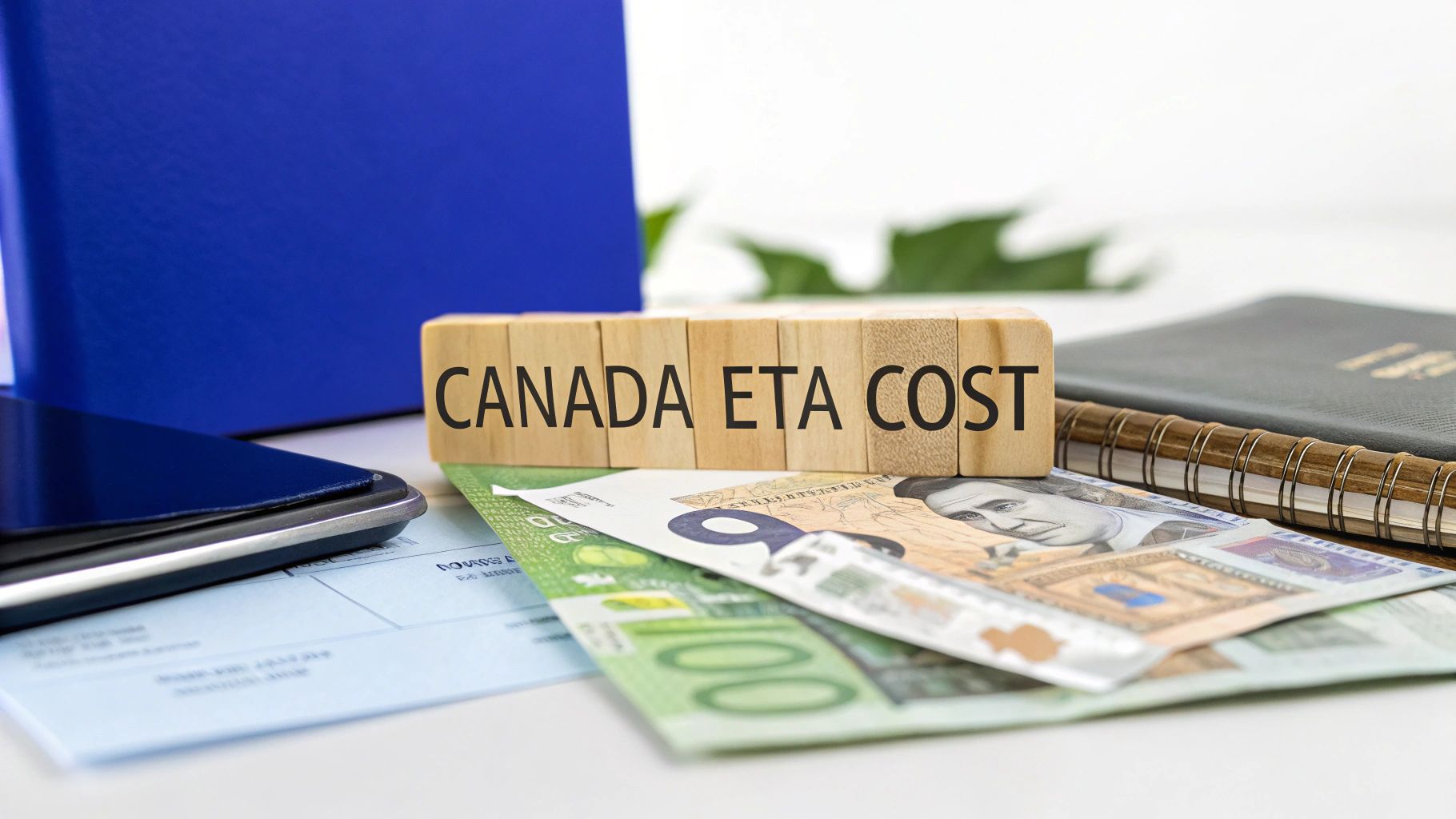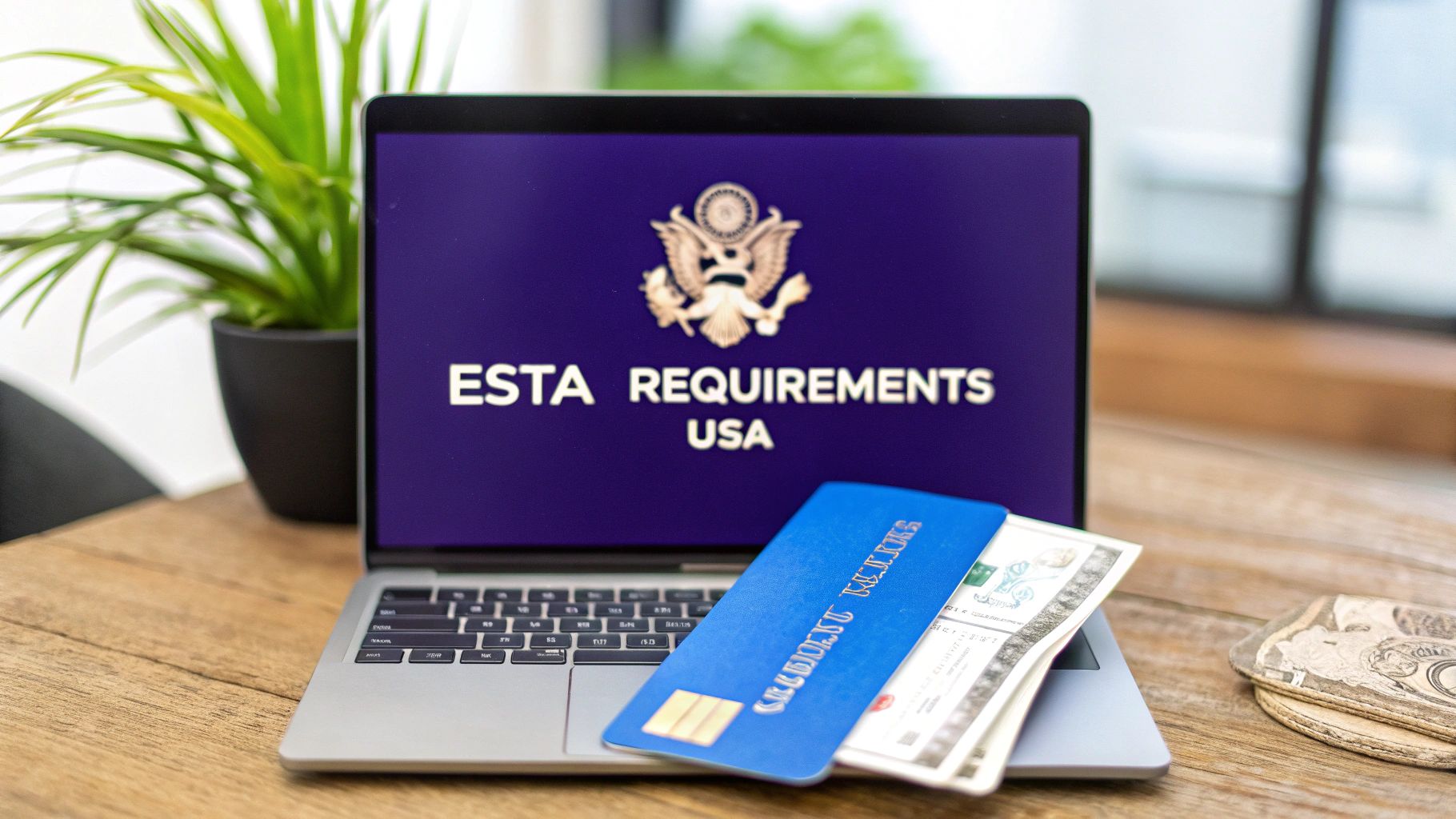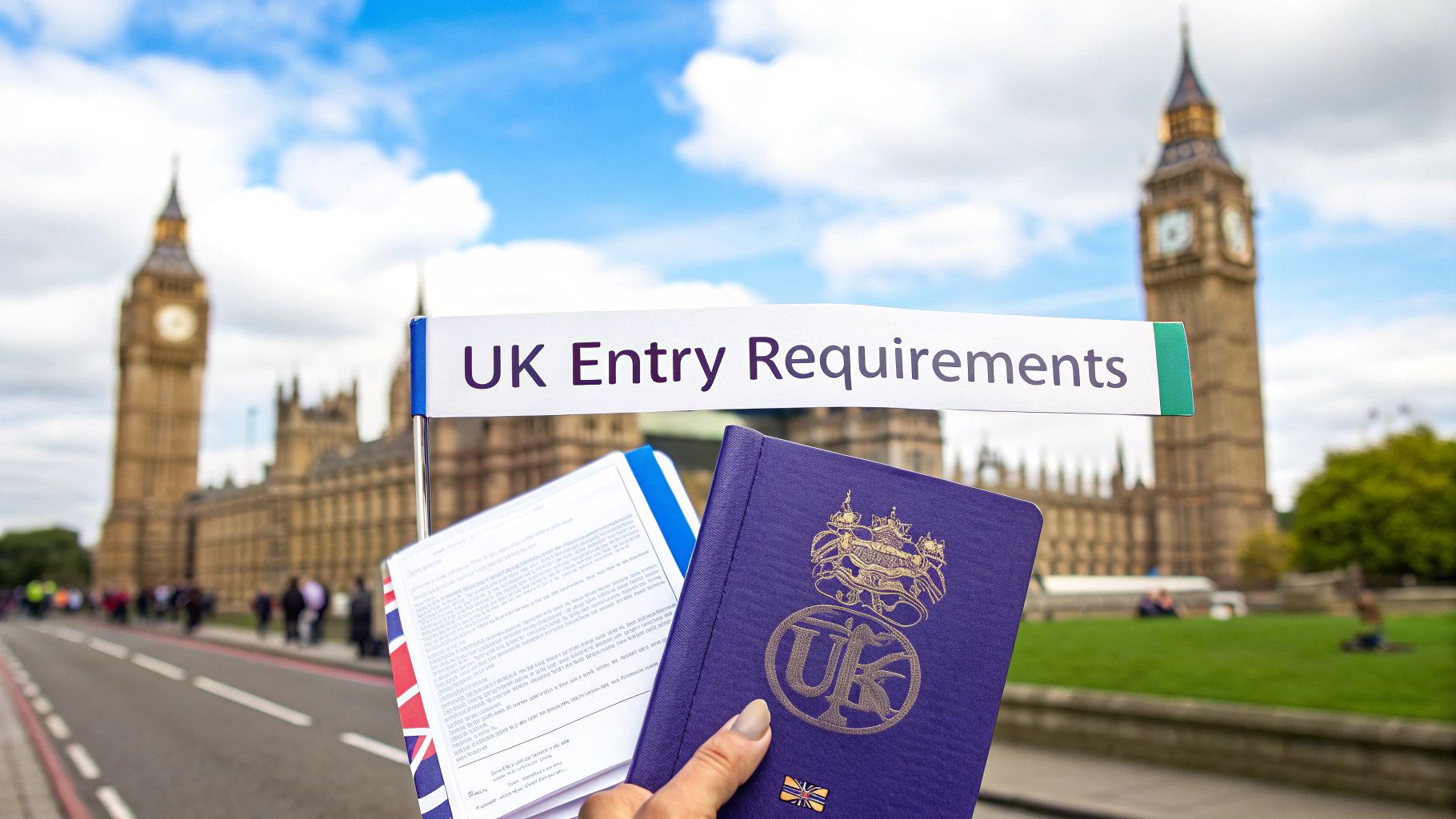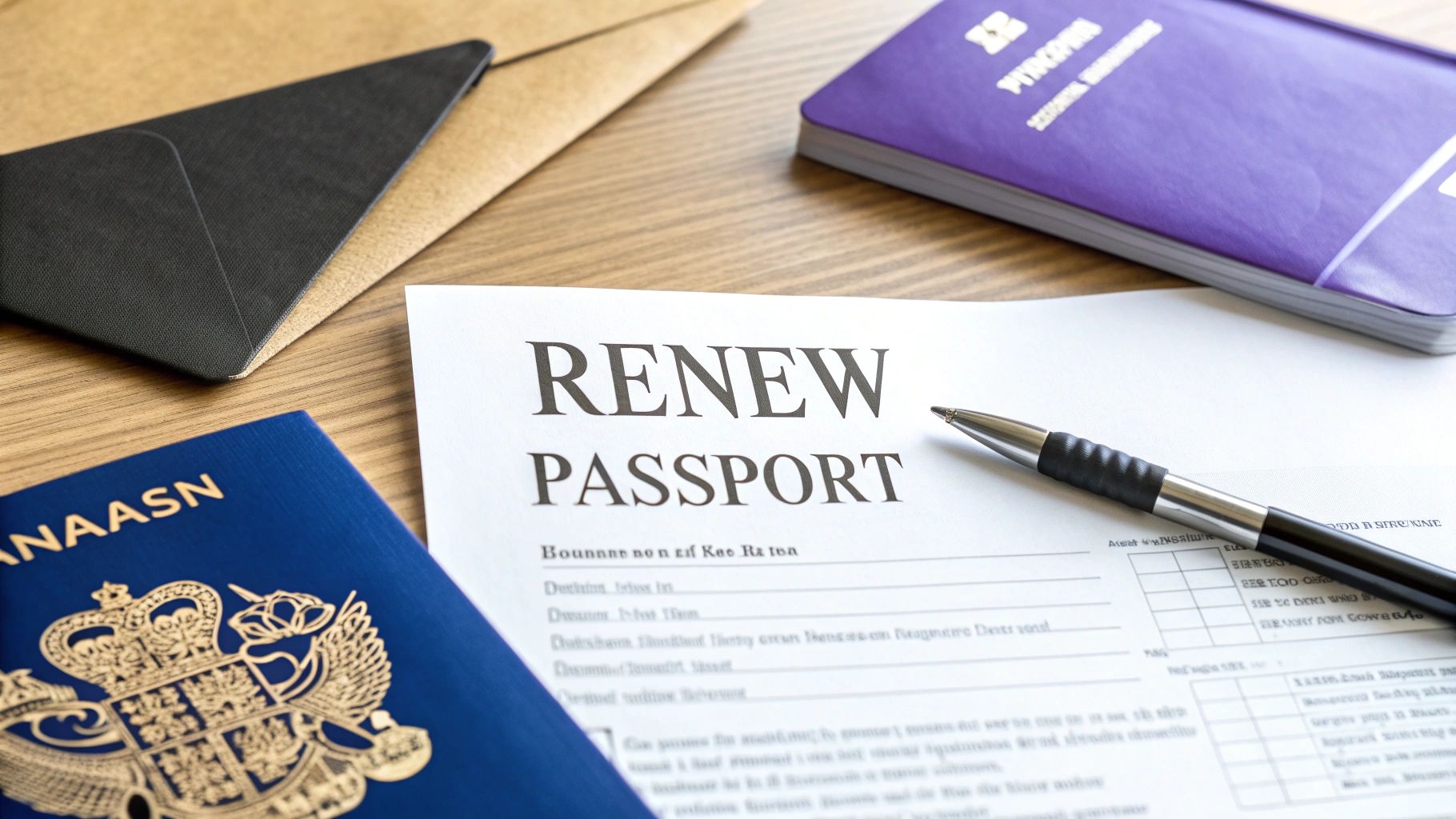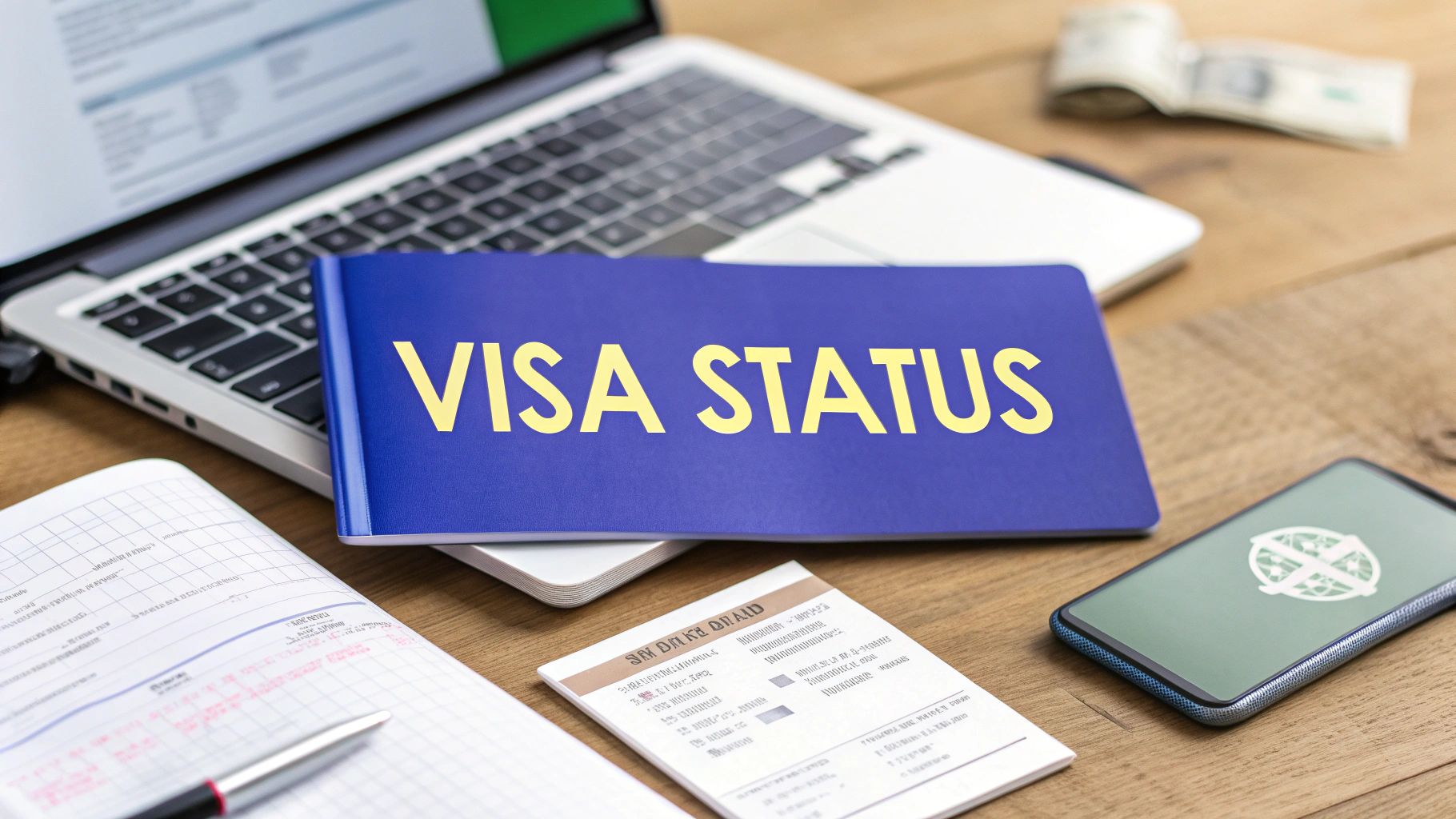
Check Your Visa Application Status with Ease
That nail-biting feeling after you’ve hit ‘submit’ on your travel application? We’ve all been there. But checking your visa application status is usually pretty straightforward, and knowing how to do it is the best way to calm those nerves.
Most government websites will ask for a unique application reference number, your passport number, and date of birth to pull up your file. For newer digital systems, like the UK's Electronic Travel Authorization (ETA), the whole process is online, giving you a quick yes or no on your travel plans.
Navigating the Visa Waiting Game
Once your application is in, the waiting game begins. This is where most travelers find themselves hitting refresh on their email, hoping for that approval to land in their inbox. Knowing where and how to check your status puts you back in the driver's seat.
Exactly how you check depends on the country and the type of travel pass you’re after. A traditional visa process, for example, often has a more clunky tracking system than a modern, digital-first application like the UK ETA. But no matter the system, you'll always need a few key details on hand.
What You'll Typically Need
Before you try to get an update, make sure you have this information ready to go:
- Application Reference Number: This is your golden ticket. It's usually in the confirmation email you received right after submitting.
- Passport Number: It has to be the exact same one you used for the application.
- Personal Details: Your full name and date of birth are almost always required to verify it's you.
Even with the right info, it's easy to get frustrated. Government websites can be glitchy, or maybe you've just misplaced that all-important reference number. The goal is to stay in the loop without adding more stress to your trip planning. Honestly, this is where a professional service can be a lifesaver.
A third-party application assistance provider like AssistEntry can handle all of this for you right from the start. Our experts manage the submission, double-check everything for accuracy, and give you clear, simple updates. It means you don't have to waste time navigating confusing government portals. For a closer look at the application process itself, check out our guide to different visa applications and what they require.
How to Check Your UK ETA Status
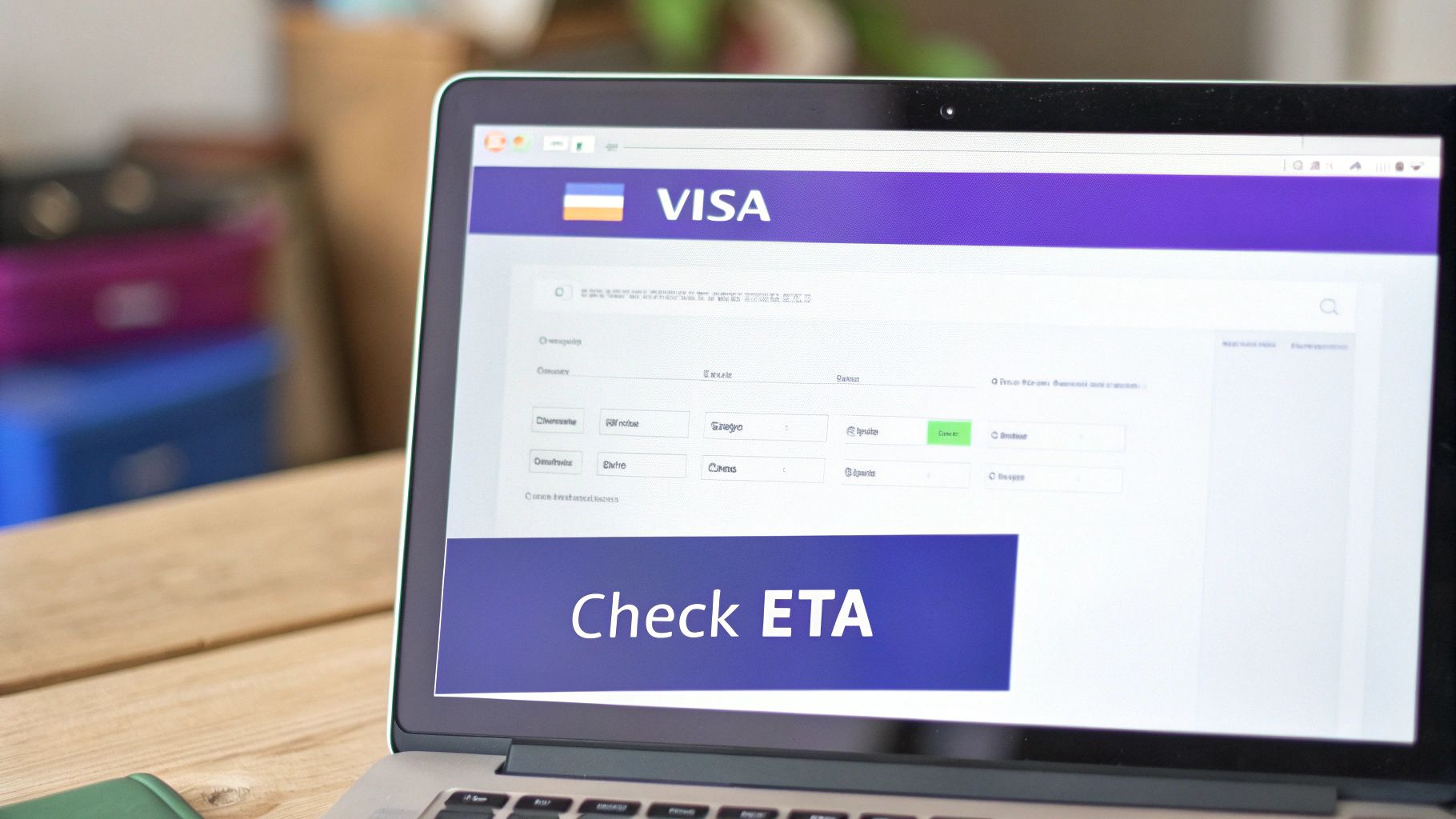
So, you’ve submitted your UK ETA application. Now comes the waiting game.
Most applications are approved within three business days, but it’s natural to want to check in on your visa application status. The whole process for this travel authorization for UK is digital, which means no paper documents or visa stamps to worry about.
To check your status on the official government portal, you’ll need the application reference number from your confirmation email. This unique ID is your key to getting an update. If you don't see the email, give your spam or junk folder a quick look—automated messages sometimes get lost in there.
The Smoother Path to Approval
Let's be honest: navigating official government websites can be clunky. Between confusing jargon and the occasional technical glitch, it's easy to feel a bit lost, especially when there's no one to call for help. This is exactly why many travelers prefer using a specialized service to handle things for them.
Instead of trying to figure out how to apply for a UK ETA yourself, you can have a team of experts manage the entire process. That’s the real benefit of using a third-party application assistance provider like AssistEntry. Our team double-checks every detail, making sure your application is perfect before it’s submitted. This simple step dramatically boosts your chances of getting a fast approval, so you won't feel the need to keep checking your status.
When you have an expert on your side, you get clear, direct communication and a real person to answer your questions. It's an invaluable support system, particularly if the government requests more information or if any issues pop up.
To simplify your ETA application and increase your chances of approval, consider using AssistEntry — their experts guide you through the entire process, starting from just $79.
This fee is all-inclusive, covering the government fee plus a thorough review of your application. An expert will perform a full verification, catching common errors and ensuring all your information meets official UK requirements. This careful oversight is designed to prevent frustrating delays and rejections.
Ultimately, choosing this route turns a potentially stressful chore into a simple, straightforward task. If you want to secure your travel authorization without the headache, learning more on the AssistEntry UK ETA page is a great place to start. You’re not just submitting a form; you’re investing in a smoother, more confident start to your UK trip.
Understanding Visa Processing Timelines
Let's be honest, one of the most stressful parts of planning a trip is the waiting game. Wondering when—or if—your visa will be approved can cause a lot of anxiety. The key to a stress-free process is setting realistic expectations for your visa application status check right from the start.
Timelines can vary dramatically depending on what you’re applying for, and it’s crucial to know the difference.
A modern travel pass like the UK ETA, for example, is built for speed. Most people get a decision within just 3 business days. It's a quick, efficient system. This is a world away from more complex applications, like a UK Standard Visitor Visa, which can easily take several weeks or even months to process. Knowing this upfront helps you manage your own timeline.
Factors That Can Delay Your Application
Even the most straightforward applications can hit a snag. It helps to know what typically causes these delays, so you can tell the difference between a normal wait and a real problem that needs your attention.
Some of the most common reasons for a longer wait include:
- Peak Travel Seasons: If you apply right before Christmas or in the middle of the summer holidays, you're competing with a massive volume of other applicants.
- Requests for More Information: If officials need another document or have a question about your application, the clock stops until you provide what they've asked for.
- A Complicated Travel History: If you've ever been refused a visa or have a complex travel record, expect your application to get a closer look. That extra scrutiny adds time.
Don't forget that major global events can also throw a wrench in the works, creating sudden backlogs that affect everyone.
We've seen this play out with Schengen visas since travel ramped up again. In 2022, only 7.5 million applications were submitted—a staggering 86% drop from before the pandemic. But that number recently shot up to 11.7 million. While it’s still not at the 2019 peak of 17 million, it shows just how fast demand can surge and overwhelm consular offices. You can dig into more of these trends and see the full Schengen visa statistics on atlys.com.
This simple infographic breaks down the typical application journey and where delays can happen.
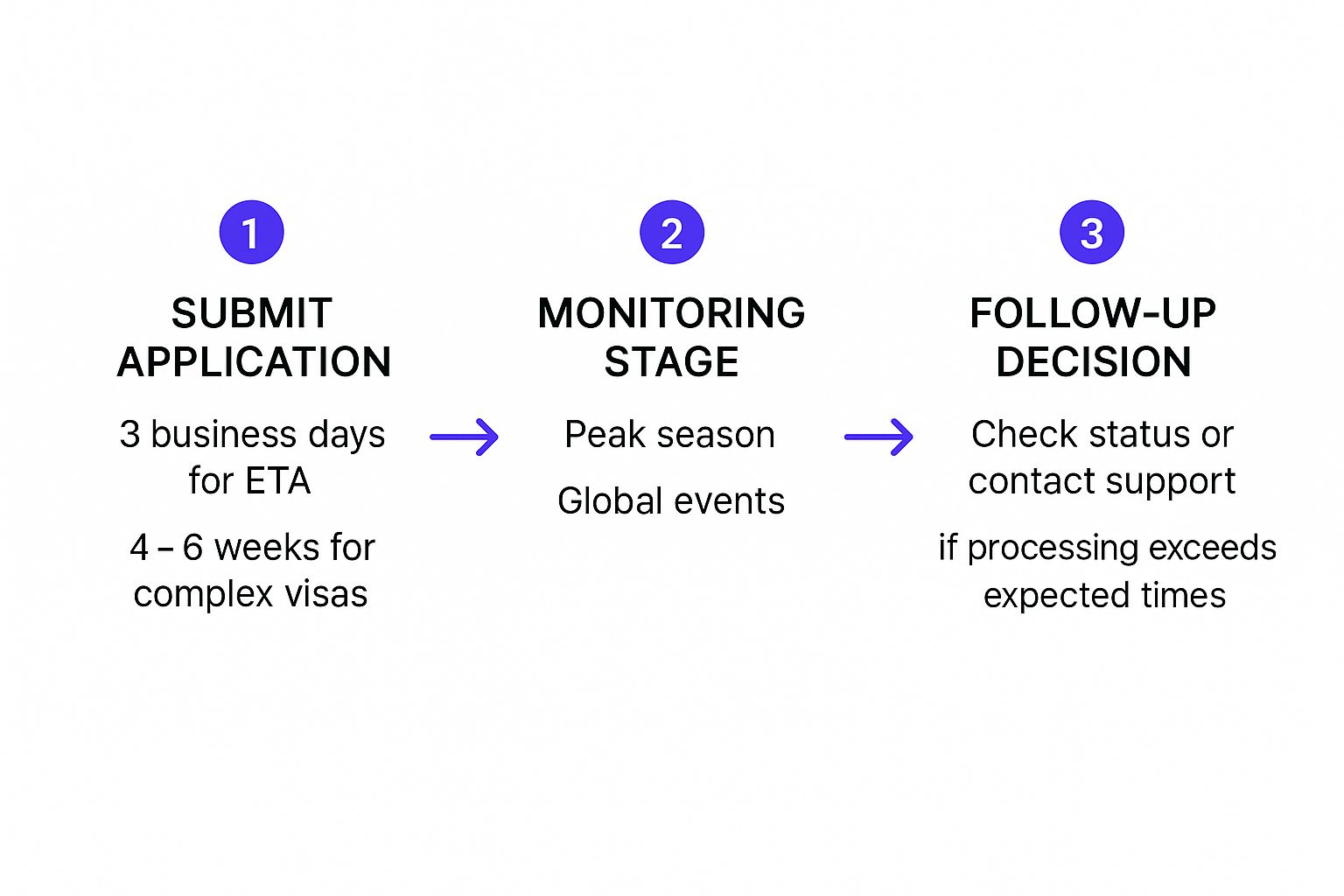
As you can see, knowing the standard timeline for your specific application is your best guide for when it's time to follow up.
When to Be Patient and When to Act
So, when does a normal wait turn into a genuine delay?
For a quick-turnaround application like the UK ETA, it's perfectly reasonable to check your status if you haven't heard anything after five business days. But for longer-term visas, you really need to wait until the official processing window has passed before you start making inquiries.
If you're navigating a more complex situation, our comprehensive guide to the UK visitor visa application process offers a much deeper dive.
Decoding Your Application Status
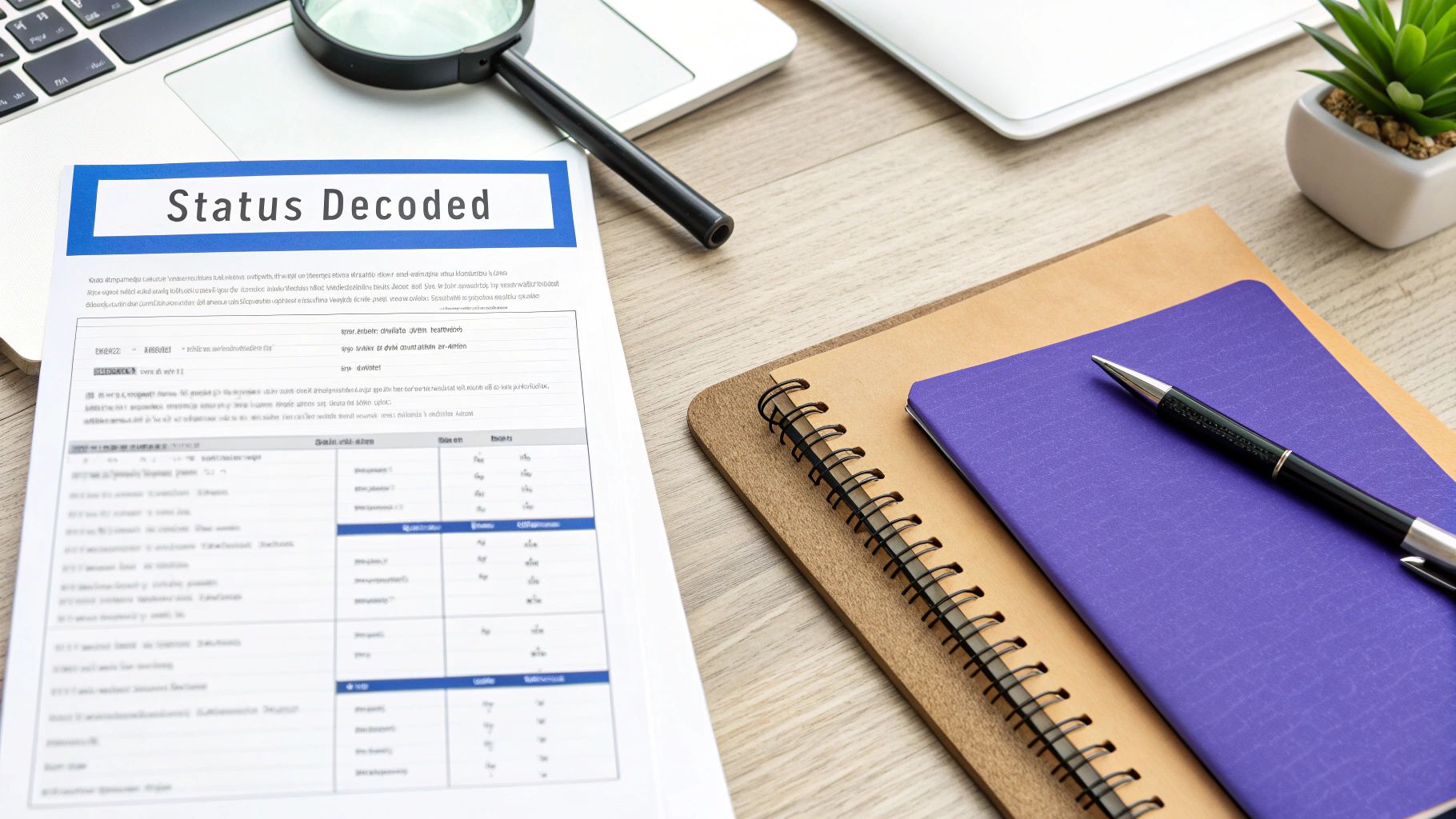
You’ve submitted your application and have been patiently waiting. Finally, you log in to check your visa application status, only to be met with official terms that feel like another language. 'Submitted,' 'Processing,' 'Action Required'—what do they actually mean?
Knowing how to interpret these updates is the key to staying in control of the process. Think of each status as a direct signal from the immigration authorities telling you exactly where your application is on its journey.
Let's break down the most common ones you'll see.
Common Statuses and Their Meanings
Submitted: This is the starting line. It’s a simple confirmation that the system has received your application. At this point, no one has actually reviewed it yet. You’re officially in the queue, so just sit tight.
Processing: This is a great sign. It means an official is now actively reviewing your documents and information. The time spent in this stage can vary wildly—from just a few hours for a UK ETA to several weeks for a more complex visa.
Action Required: Pay close attention if you see this one. It means the review has been paused because the officials need something more from you. You’ll almost always get an email asking for additional documents or clarification. Check your inbox (and your spam folder!) immediately and respond as quickly as you can to get things moving again.
This is where having an expert on your side really pays off. If a request for more information comes through, a third-party service like AssistEntry knows exactly how to respond, ensuring you provide the right documents without any delay.
The Decision Statuses
Eventually, your status will change one last time to a final decision. This is the moment of truth, and it's crucial to understand what each outcome means for your travel plans.
Approved (or Granted): This is the news you’ve been waiting for! Your application was successful. Your travel authorization will either be attached to the notification email or digitally linked straight to your passport. You are officially cleared for travel.
Refused (or Denied): This is always disappointing, but it's not necessarily the end of the road. A refusal will always come with an explanation. For a UK ETA application, common reasons can be as simple as a data entry error or not meeting a specific eligibility rule. The most important thing is to read the reason they provided.
If you just made a small mistake on your ETA, you can often correct it and simply reapply. In other cases, a refusal might mean you need to apply for a different type of entry clearance, like a Standard Visitor Visa. To learn more about navigating these rules, you can explore our detailed overview of the UK ETA and its specific criteria.
Troubleshooting Common Status Check Issues
It’s a sinking feeling. You go to check your visa application status, and the system bluntly states, "Information not found." Before you start to worry, take a deep breath. This is an incredibly common hiccup, and it's almost always a simple fix.
More often than not, the culprit is a tiny typo. That long string of letters and numbers in your application reference is easy to get wrong. Carefully type it in again, paying close attention to characters that love to be confused, like the number '0' and the letter 'O', or the number '1' and the letter 'I'.
Another frequent mistake is checking your status on the wrong website. Always make sure you're on the official government portal for the country you're visiting. A good habit is to bookmark the site right after you apply to save yourself a headache down the road.
Solving Common Access Problems
Okay, so you've double-checked your details and you're definitely on the right website, but you're still locked out. Let's dig a little deeper into the most common roadblocks people run into.
- Lost Confirmation Email: This email is your golden ticket—it holds your reference number. If you can't find it, start with a thorough search of your inbox. Don't forget to check your spam, junk, and promotions folders. Use keywords like "UK ETA," "application," or the name of the government agency.
- Missing Reference Number: If that confirmation email has truly vanished, your options with official government portals are pretty limited. This is where you might have to try contacting a consulate directly, but getting a quick response can be a real challenge.
- Incorrect Personal Data: Make sure the passport number and date of birth you're entering are an exact match to what you put on your application. You’d be surprised how many errors come from a simple mistyped passport number. Our guide on how to scan a passport correctly has some great tips to help you avoid these data entry mistakes from the get-go.
The Value of a Safety Net
Going through these troubleshooting steps really shows the massive advantage of using an application assistance service. When you apply through a provider like AssistEntry, you get a built-in safety net. They securely manage all your application details, including that all-important reference number.
Instead of trying to navigate a faceless government system all by yourself, you have a direct line to an actual support team. If you can't find your confirmation email or have a question, their experts are right there to help you. That kind of immediate support is nearly impossible to get from government agencies.
This service, which also includes a full review of your application for any errors, gives you real peace of mind. Knowing an expert has already double-checked your submission for accuracy means you’re far less likely to run into a confusing status update in the first place.
Common Questions About Your Visa Status
Even with a clear guide, that waiting period after you submit your visa application can bring up a lot of "what if" scenarios. Getting straight answers to common questions can give you some much-needed peace of mind and help you figure out what to do next.
Let's walk through some of the questions we hear most often from travelers.
What Should I Do If My UK ETA Application Is Refused?
Seeing a "Refused" status can feel like a huge setback, but it's important not to panic. A refusal is not a ban.
The very first thing you need to do is read the refusal notice carefully. It will tell you exactly why the application was denied. Often, it's something as simple as a typo in your passport number, a failed eligibility check, or missing information.
For most travelers, the next step after a UK ETA refusal is to apply for a Standard Visitor Visa. This is a much more detailed process, so it's critical to get everything right this time. This is where getting some expert help can make all the difference.
An experienced service can help you address the specific reasons for the initial ETA refusal. They'll make sure your new visa application is complete, accurate, and structured to meet the tougher requirements.
How Long Should I Wait Before Following Up?
Patience is a virtue here, but you also don't want to be left in the dark. First, double-check the official processing timeline. For the UK ETA, the standard wait time is up to three business days.
If three days go by and you still don't have a decision, I'd suggest waiting another two or three business days before reaching out. Small operational delays happen all the time. After that, what you do next depends on how you applied.
- Official Portal: If you applied directly on the government website, look for an official contact or inquiry form.
- Assistance Service: If you used a third-party service like ours, just contact their support team. That should be your first and only step. They know the ins and outs of the timelines and can give you a clear update or advise you on what to do.
Can I Travel If My UK ETA Is Still Processing?
This one is a hard no. You absolutely must have an official 'Approved' status for your UK ETA before you head to the airport for your trip to the United Kingdom.
Airlines are required by law to check that every passenger has valid travel authorization before they let you on a UK-bound flight. If your application is still pending, you will be denied boarding. There’s no way around this rule, so make sure you apply well ahead of your travel dates to avoid a very stressful situation at the airport.
Does Checking My Application Status Frequently Speed It Up?
It's a common myth that hitting refresh on the status page will somehow push your application to the top of the pile. The reality is, checking your visa application status—even a hundred times a day—has zero effect on how quickly it gets processed.
The system only updates when an officer completes a stage in the review. While it's totally normal to feel anxious and want an update, the best approach is to check just once a day or, even better, just wait for the official email. This is another area where an assistance service really helps; they do the monitoring for you and let you know the second something changes, so you don't have to.
Avoid the common pitfalls and stress of the application process. The experts at AssistEntry provide full verification and error-checking to increase your chances of a quick approval. To get started with a service that handles everything for you, visit the AssistEntry’s UK ETA page, with prices starting from just $79, all-inclusive.
